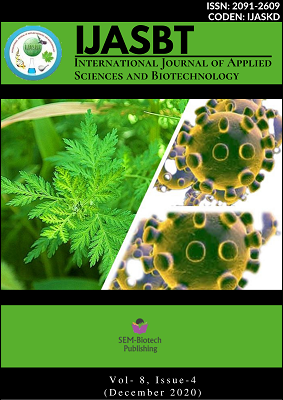Benefit Cost Analysis of Small Farm Machineries Used for Rice Cultivation in Nepal
DOI:
https://doi.org/10.3126/ijasbt.v8i4.31928Keywords:
Rice, B/C, NPV, IRR, Payback, Sensitivity analysis, SubsidyAbstract
A study was conducted in Jhapa, Sunsari and Bardiya district of Nepal to assess the benefit cost (BCA) analysis of small farm machineries (transplanter, reaper and power tiller) used for rice cultivation. Out of total respondents of 274 under mechanized farm category selected using Raosoft Software of sample size determination, 74% reaper owner (20), 67% power tiller owner (20) and 100% transplanter owner (09) were selected for analyzing benefit cost analysis using simple random sampling. BCA analysis showed that the NPV, B/C ratio, IRR and Payback Period of investing in transplanter were NRs 452743.62, 1.61, 24% and 2.75 years at 12% discount rate respectively. Similarly, NPV, B/C ratio, IRR and Payback period for reaper and power tiller were NRs 422541.93, 2.89, 123% and 1.14 years and NRs 619,719.34, 2.32, 65% and 1.46 years at 12% of discount rate respectively. The investment on reaper and power tiller would be profitable for their higher Benefit Cost ratio and IRR, and lower payback period. The results of sensitivity analysis showed that investments in reaper and power tiller would be profitable even if decrease in benefit or increase in cost or decrease in benefit and increase in cost by 20% is considered. However, in case of transplanter, the IRR would be less than the discount rate when benefit decreases by 20% and cost increases by 20%. Due to high investment at the initial stage, the payback period was longer and IRR was also less than 30% per annum in transplanter which indicated that investment would not be made for transplanter unless price of transplanter is lowered through regulation of price and provision of subsidy. It is suggested to motivate farmers for adoption of small farm machineries in rice cultivation through provision of differentiated rates of subsidy and technical capacity build up.




